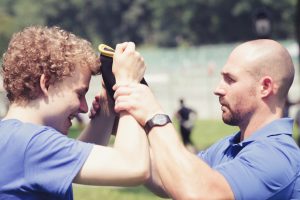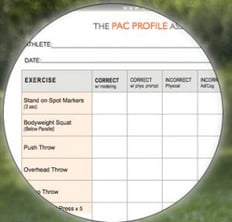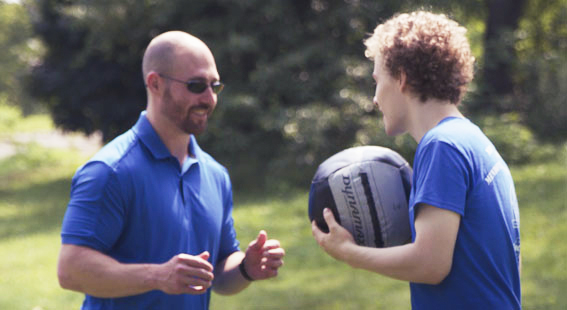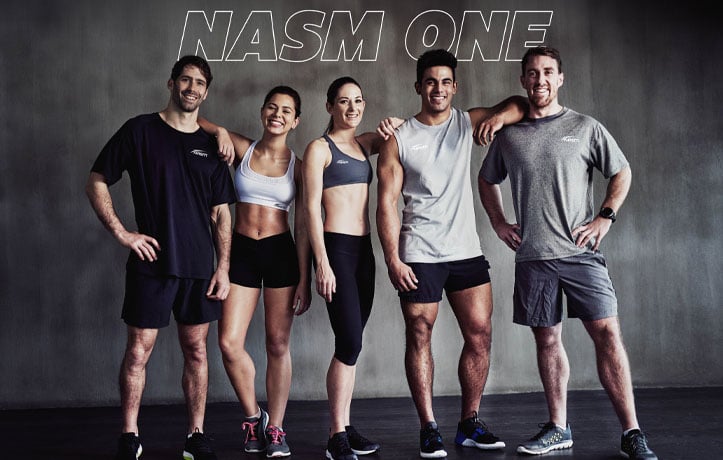Autism spectrum disorder (ASD) is on the rise. Reliable statistics on the total population don’t exist, but estimates suggest that the figure has increased over the past decade to include about 1.5 million Americans. If you’re considering working with clients who have ASD, it’s important to educate yourself first, says exercise physiologist Eric Chessen, MS, YCS, NASM-PES, and founder of Autism Fitness, based in Long Island, New York.
“There’s a significant difference between having the motivation to be helpful and actually putting together an effective program for this population,” says Chessen, who began working with people with autism more than a decade ago. “What I care about is programming and developing effective ways of building fitness for this population and for trainers working with them,” he says. “It’s a good start to want to give back, but when you have an individual who is 19 or 20 years old and has some real behavior issues, all of the feel-good part goes away real quickly, and you want strategies to deal with the situation effectively. That’s kind of where I live.”
While most of us know someone “on the spectrum,” we may not know much about ASD. For starters, spectrum is an important word to remember because this developmental disability is associated with a range of challenges that can affect people’s social lives, communication and behavior to widely varying degrees. People with ASD may have ways of acting, thinking, learning, paying attention and reacting to stimuli and situations that differ from people with neurotypical development. Some people with ASD are classified as gifted, while others may face serious challenges. Many benefit from a variety of interventions in their daily life, though others need far less. Regarding fitness, this population tends to exhibit deficits in motor skills and strength, they need to be incentivized and reinforced more than neurotypical clients, and they may face additional challenges in understanding and performing exercise movements, which necessitates an in-depth examination of the client’s learning style followed by appropriate modifications to coaching and cueing techniques.

For Chessen, working with people with an ASD diagnosis is both a mission and a passion. “I love being able to provide a service that’s absolutely necessary to a population that is often overlooked and that desperately needs fitness as part of their life,” he says. We asked Chessen to share some of his time-tested strategies for creating programming for people with ASD. (Bonus points: Even if you’re not sure you’ll be working with people with ASD, consider each of these strategies in reference to your current clients, too. Many of Chessen’s insights can provide an interesting perspective, as well as inform and enhance your current methodologies!)
How to Assess Athletes with ASD
Chessen begins with a comprehensive assessment tool he created called the PAC Profile, which evaluates the client’s Physical, Adaptive and Cognitive abilities. “Those are the three attributes that we have to consider with any population, but with this population in particular,” says Chessen. In short, for each exercise you teach the athlete, you need to know that your client can physically do it, that they’re motivated enough to do it, and that they’re cognitively able to understand the directions you’re giving. Success comes only after all three are accounted for, says Chessen. If something isn’t working during a workout session, he says, that’s a sign that there’s a breakdown in one of these three areas.
 PAC Profile
PAC Profile
When working with people with ASD, it’s important to understand the difference between “can’t” and “won’t.” If an athlete is willing to perform only three hurdle steps before they wander off (known in behavioral therapy as eloping or off-task behavior), Chessen wants to know whether it’s because they don’t have the strength or endurance to do a fourth hurdle jump…or whether they are physically capable but need more incentive to do so. An assessment may not immediately answer that question, but it creates a baseline from which to track the client’s progress.
He notes that the first few sessions may not offer a clear view of a client’s physical ability because the athlete may view the situation as anxiety-provoking. Or they may not yet understand what’s expected of them. “I would much rather start at a point of success and build up their tolerance to extended periods of activity than see a coach chasing around an individual saying, ‘This is really fun!’” says Chessen. Which dovetails with his next pointer…
Why You Can’t Force Fun
While fitness professionals generally view exercise as fun, we need to remember that this may not be the view of some clients, particularly those with ASD. “They have some rigidity in their behaviors and they have a limited scope of activities that they will engage in—usually movement and exercise not being included amongst those,” he says. Case in point: If Chessen takes a client to a playground and starts getting out multicolored cones, Sandbells and medicine balls, he will have neurotypical adults and kids gravitating toward him because they want to play and explore. People with ASD, however, will need some extra motivation to pick up that medicine ball or Sandbell.
“The question that I like to ask myself periodically is: What is it like for you to be coached by me right now?” says Chessen. “As a coach, I understand the significance and the importance of doing a nice strong and stable squat, but for an individual who doesn’t do well with abstractions, it’s not going to be important for them. We have to build in the importance.” The key, says Chessen, is developing contingencies (if/then conditions) that are clearly understood by the athlete.
Contingencies are based upon pairing a “novel” or “non-preferred’ activity with access to a preferred activity. In brief, the idea is: “If you do X (which you don’t like), then you can do Y (which you enjoy).” By pairing a non-preferred activity with a preferred one, the participant becomes motivated to comply. This is true for everyone, not just people with ASD. (Note: This is somewhat simplified; human behavior is governed by many variables.) For instance, Chessen says that you might not be interested in trying Malaysian food if it is new to you, but if you go to a Malaysian restaurant with a group of friends and you’re enjoying the company and conversation, you’ll be more likely to sample and possibly even savor those new flavors.
In time, says Chessen, that initial non-preferred activity can become a reinforce itself. After a few months of doing hurdle steps in order to be allowed a preferred activity (such as walking around the room or taking a break), for instance, the athlete with ASD may ask to do hurdle steps after performing a new exercise such as medicine ball throws. That’s because they’ve done hurdle steps so often that they’re now familiar, and the athlete both understands and can physically complete the move successfully. The result: The previously non-preferred activity has now become a reinforcer for trying something new.
“We want to have this ever-growing list of reinforcers that we can use to the point that it becomes what looks like a normal exercise session,” says Chessen. “And that’s how you actually make things fun, rather than just labeling it. Fun is something we’ll engage in without a secondary reinforcer. If a thing needs to be incentivized, it’s not fun. But if we incentivize it, it eventually becomes fun.”
Why You Shouldn’t Be Afraid to NOT Mix Things Up
As a fitness professional, it’s tempting to try the latest modalities or add new equipment or moves to your toolbox. For people with ASD, though, variety may be both unnecessary and anxiety-provoking. What’s more, says Chessen, it’s missing the point of the workout session, which is to improve the client’s strength and physical movement.
For these reasons, Chessen focuses on squatting patterns, crawling patterns, and pushing and pulling. Just because an athlete can spend 30 minutes on the treadmill, says Chessen, that doesn’t mean they should. “The majority of programming for my athletes looks the same because they all need the same things,” he explains. “So I’m not going to change my hurdle-step-to-bear-walk-to-medicine-ball-throw from athlete to athlete simply because I think all of their programs should look different.”
What does differ is the progressions or regressions—how an exercise can be simplified so it can be performed successfully or made more challenging when the athlete’s abilities warrant a change. “Building-in things just because they seem novel doesn’t make sense,” he says. “And it will inevitably fall apart with a population that does not do well with abstract concepts and multistep directions.”

What Other Strategies Can Have a Big Impact
- Maintain consistency. Alleviating anxiety plays a huge part in the success of this population. Being clear about expectations and instructions helps athletes feel safer, more engaged, happier and more comfortable during the session. If you maintain consistency, says Chessen, you’ll see progress.
- Let them choose break-time activity. When his clients are on their 2-minute break (after performing a non-preferred activity), Chessen lets them choose what to do. Sometimes they wander around the room, roll around on the crash mat, or sit in the ball pit. As long as they’re safe, Chessen doesn’t worry about what they select since that “preferred activity” is incentivizing them.
- Take a team approach. Chessen recommends looping in any health professionals who are currently working with the athlete. They often can provide information into behavior and health issues, as well as suggestions of what might work well with that athlete if, for instance, they begin to get off-task. Sharing information and asking questions can make for a better outcome for everyone.
- Manage your expectations. Each client is very different. A first visit, for some, may be as simple as arriving at the gym, getting out of the car, and looking at the building. Others may spend an entire session wandering around the gym to become acclimated. The next time, they may progress to standing in a circle on the floor for 2 seconds. Once the athlete has become familiar with the routine, trainer, and location, progress can begin to happen much more quickly.
- Consider your own needs. For Chessen, providing this service that is “not widespread” is, in itself, rewarding—incentivizing. But he doesn’t believe that working with this population is for everyone. “You can’t teach patience,” he says. If you thrive on positive feedback from clients, you’re not likely to receive it from people with ASD. “I’m not waiting for them to run over and hug me and say how much fun they’re having,” he says. “I’m waiting for them to go to the battle ropes when I haven’t told them to. That shows me that something has clicked.”
How to Take Your Training to the Next Level
Having spent 13 years developing his programming and strategies, Chessen now wants to share what he has learned, teaching it to fitness trainers, PE teachers, special educators, OT/PTs, behavior therapists, parents and other interested parties. “It’s not about what I can do. It’s about the information I can give to others,” he says.
To that end, Chessen now offers several packages for professionals and parents who want to begin developing a fitness/PE program for those with ASD or to enhance an existing curriculum or practice.
- The Autism Fitness Toolbox. This includes in-depth coverage of the PAC Profile Assessment, key concepts and methods, exercises (with progressions and regressions), videos featuring Autism Fitness athletes, flow charts (to aid in planning), and programming templates for complete fitness sessions.
- The Autism Fitness Seminars and Certification. This comprehensive program for fitness professionals dedicated to working with the ASD population.
To learn more, peruse Chessen’s ebooks and equipment offerings, or download the free ebook The Top 8 Exercises for Autism Fitness, visit autismfitness.com and autismfitnesstoolbox.com.
“To me, my program has no value if it’s not being used,” says Chessen. “If someone uses it and it makes sense to them, then it has value.”
References
Advancing Futures for Adults with Autism. About AFAA: Autism on the Rise. Accessed No 20, 2016. www.afaa-us.org.
http://www.afaa-us.org/about
Autism Speaks. 2016. Facts about Autism. Accessed No 20, 2016. www.autismspeaks.org https://www.autismspeaks.org/what-autism/facts-about-autism
CDC. 2016A. Autism Spectrum Disorder (ASD). Accessed Nov 19, 2016. www.cdc.gov.
http://www.cdc.gov/ncbddd/autism/index.html
CDC (Centers for Disease Control and Prevention). 2016B. Facts About ASD. Accessed Nov 19, 2016. www.cdc.gov.
http://www.cdc.gov/ncbddd/autism/facts.html
CDC (Centers for Disease Control and Prevention). 2016C. New Data on Autism: Five Important Facts to Know. Accessed Nov 19, 2016. www.cdc.gov.
















